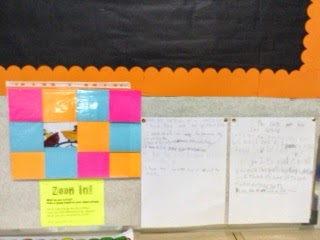This book was a source of inspiration last week to practice multiplication skills:

Before I even opened the book, I explained to the kids that this is a book that many teachers use... with their kindergarten students.
This was hilarious to them! Half of them were sort of saweeeet and the other half was sort of laaaaame.
I asked them to think of how this book might be used in younger grades as we read.
They came up with the expected: learning to count, learning the names of new animals, counting to ten, adding to ten, etc.
Then I asked them to think of how we might use it in a way that's more appropriate to grade three, considering our current learning.
They decided that we could practice our 10s facts.
Which they then quickly decided was a bit useless because everyone knows those - yawn.
Then we thought about how we could combine our prior knowledge in addition with our strategies to solve other multiplication facts, and this is what we got:
They chose a two-digit number and figured out which animals could be added and multiplied together to show it, and illustrated this using the book as inspiration.
This is one I'll definitely be saving for next year, too!

This was hilarious to them! Half of them were sort of saweeeet and the other half was sort of laaaaame.
I asked them to think of how this book might be used in younger grades as we read.
They came up with the expected: learning to count, learning the names of new animals, counting to ten, adding to ten, etc.
Then I asked them to think of how we might use it in a way that's more appropriate to grade three, considering our current learning.
They decided that we could practice our 10s facts.
Which they then quickly decided was a bit useless because everyone knows those - yawn.
Then we thought about how we could combine our prior knowledge in addition with our strategies to solve other multiplication facts, and this is what we got:
They chose a two-digit number and figured out which animals could be added and multiplied together to show it, and illustrated this using the book as inspiration.
This is one I'll definitely be saving for next year, too!











.JPG)
.JPG)
.JPG)

.JPG)






















.JPG)






.JPG)

.JPG)
.JPG)
.JPG)
.JPG)

.jpg)




